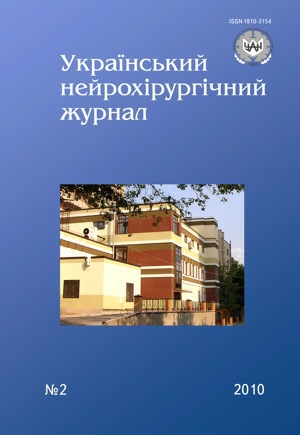Influence of early syndromes of systemic inflammatory response and poliorganic insufficiency on lethality at cranio-cerebral trauma
DOI:
https://doi.org/10.25305/unj.89667Keywords:
cranio-cerebral trauma, poliorganic insufficiency syndrome, syndrome of system inflammatory response, SOFA scale, Glasgow coma scale, lethalityAbstract
Poliorganic insufficiency syndrome (PIS) is one of the main reasons for lethality at cranio-cerebral trauma (CCT). It develops gradually and seen before death (late PIS) at 95% patients. If PIS it diagnosed too late the treatment and prophylactics measures are ineffective. At the same time, PIS first signs (early PIS) are detected at hospitalization that can help in prognosis of posttraumatic period flow and lethality and to prescribe treatment needed. At 227 patients with CCT main reasons and factors that influence on PIS developing and lethality were investigated. The influence of early syndrome of system inflammatory response, patient’s age, sex, trauma heaviness, intracranial haematomas size, alcohol concentration in blood on PIS and lethality frequency and expression was studied, possibility of their early prognostication was shown that allow to begin treatment and prophylactics measures in time.References
Черепно-мозговая травма: прогноз течения и исходов / [Л.Б. Лихтерман, В.Н. Корниенко, А.А. Потапов и др.]. — М.: Книга ЛТД, 1993. — 299 с.
Черепно-мозкова травма: сучасні принципи невідкладної допомоги / Є.Г. Педаченко, І.П. Шлапак, А.П. Гук, М.М. Пилипенко. — К., 2007. — 224 с.
Клиническая эпидемиология черепно-мозговой травмы / Е.Г.Педаченко, С.Я.Семисалов, В.Н.Ельский, А.М.Кардаш. — Донецк: Апекс, 2002. — 156 с.
Черний В.И. Роль синдрома системного воспалительного ответа в патогенезе травматической болезни головного мозга / В.И. Черний, Г.А. Городник // Біль, знеболювання і інтенсив. терапія. — 1998. — №3(4). — С.50–54.
Multiply organ failure: pathophysiology, prevention, and therapy; eds. A.E. Baue, E. Faist, D.E. Fry. — N.Y.: Springer-Verlag, 2000. —437 р.
Bone R.C. A personal experience with SIRS and MODS / R.C. Bone // Crit. Care Med. — 1996. — V.24, N8. — Р.1417–1418.
Кижаева Е.С. Полиорганная недостаточность в интенсивной терапии / Е.С. Кижаєва, И.О. Закс // Вестн. интенсив. терапии. — 2004. — №1. — С.14–18.
Роль системно-воспалительного ответа и полиорганной недостаточности в исходе лечения больных с тяжелой черепно-мозговой травмой / Л.П. Чепкий, С.В. Минов, С.А. Андреев [и др.] // Матеріали IV з’їзду нейрохірургів України (Дніпропетровськ, 27–30 трав. 2008 р.). — Дніпропетровськ, 2008. — C.183.
Особенности мультиорганной недостаточности при тяжелой черепно-мозговой травме / Л.П. Чепкий, С.А. Андреев, С.В. Минов, Р.В. Гавриш // Біль, знеболювання і інтенсив. терапія. — 2008р. — №2(Д). — C.328–330.
Cramp I.M. Analysis of multiple organ system failure in trauma and nontrauma patient / I.M. Cramp, D.A. Duncan, R. Wears // Amer. Surg. — 1988. — N12. — P.72–78.
Сепсис и нозокомиальная инфекция / [В.Ф. Саенко, В.И. Десятерик, Т.А. Перцева и др.]. — Кривой Рог: Минерал, 2002. — 226 с.
Глумчер Ф.С. Вплив трахіостомії на внутрішньочерепний тиск у хворих з тяжкою черепно-мозковою травмою / Ф.С. Глумчер, С. Оджум // Біль, знеболювання і інтенсивна терапія. — 2008. — №2(Д). — С.71–73.
Смирнова Л.М. Концепція органопротективного знеболювання / Л.М. Смирнова. — К.: Ліга інформ, 2009. — 221 с.
Сизов Д.Н. Синдром последовательных органных повреждений у пациентов в критических, состояниях / Д.Н. Сизов, А.Л. Костюченко, А.Н. Вельских // Анестезиология и реаниматология. — 1998. — №2. — С.22–25.
Старенькая И. Нейропротекция при синдроме полиорганной недостаточности / И. Старенькая // Здоров’я України. — 2005. — №119. — С.14–16.
Чепкий Л.П. Травматическая болезнь / Л.П. Чепкий // Междунар. мед. журн. — 1999. —Т.5, №1. — С.106–109.
Schiffl H. Daily hemodialysis and the outcome of acute renal failure / H. Schiffl, S.M. Lang, R. Fischer // New Engl. J. Med. — 2002. — V.346. — P.305–310.
Downloads
Published
How to Cite
Issue
Section
License
Copyright (c) 2010 L. P. Chepkiy, S. V. Minov

This work is licensed under a Creative Commons Attribution 4.0 International License.
Ukrainian Neurosurgical Journal abides by the CREATIVE COMMONS copyright rights and permissions for open access journals.
Authors, who are published in this Journal, agree to the following conditions:
1. The authors reserve the right to authorship of the work and pass the first publication right of this work to the Journal under the terms of Creative Commons Attribution License, which allows others to freely distribute the published research with the obligatory reference to the authors of the original work and the first publication of the work in this Journal.
2. The authors have the right to conclude separate supplement agreements that relate to non-exclusive work distribution in the form of which it has been published by the Journal (for example, to upload the work to the online storage of the Journal or publish it as part of a monograph), provided that the reference to the first publication of the work in this Journal is included.









